Wildseed Farms Fires it up this July, 2007,
with a new twist Gourmet Chili Pepper and Salsa Festival
Spice it up! July, 2007
Wildseed Farms announces a new festival this summer on July
28 and 29, called the Gourmet Chili Pepper and Salsa Festival.
Wildseed Farms, known for its flowers, has planted several fields
of peppers: chilis for ristras and drying, specialty and ethnic
peppers, sweet and hot peppers, southwestern style chills, ornamental
peppers and more.

PEPPERS and John Thomas in front of zinnias in July, 2007
===============
The dates are July 28, 10 a.m. - 10 p.m. and July 29, noon -
6 p.m.; Admission, 12 and older $8, under 12 - $2. The admission
includes everything at Wildseed Farms: Festival grounds, Tasters
Tent, Guest Chefs and Speakers, Butterfly Haus, Market Center,
Brewbonnet Biergarten, colorful wildflower fields, and spicy pepper
fields. Pick your own flowers and/or peppers, $3.50 per container.
John R. Thomas, Wildseed's founder and president, knows that color
reigns on the vast, open fields along the highways. In 1983, there
were very few sources for wildflower seeds; the seeds that were
available were prohibitively expensive. The public*s love of wildflowers
and demands from landscape contractors and the highway department
motivated Thomas to turn his sideline turf seeding business into
a full time wildflower farm. In addition, he developed a machine
to plant the tiny seeds and another to harvest them. Then the
new company pioneered the practice of planting wildflowers in
rows on large acreage. Today, Wildseed Farms is the largest working
wildflower farm in the U.S. At its Hill Country headquarters,
the farm has more than 200 acres under cultivation. Wildseed Farms
produces 88 varieties of wildflower seeds.
This new festival will not only promote chili peppers and wildflowers
but educate the folks as well. Speakers and Chefs scheduled: JOHN
R. THOMAS: Taking the wild out of wildflowers; AL WAGNER: So you
want to make and market your own salsa; Chef ROSS BURTWELL: Having
fun with spices; LARRY STEIN: Growing peppers successfully; JERRY
PARSONS: Hot peppers and insane peppers; and DAVID RODRIGUEZ:
Beautiful landscape color in the Texas heat.
Some of the great music lined up: Stereo Highway, Thomas Michael
Riley, Zydeco Blanco and the Bill Smallwood Jazz Band just to
name a few. Plus booths to sample salsas.
For more information call 830-997-8515 or toll free 1-866-839-3378
or visit www.wildseedfarms.com or http://www.tex-fest.com/
===========================================================
===========================================================
GOURMET CHILI PEPPER & SALSA FESTIVAL
JOIN US FOR SOME INTERESTING TALKS
AL WAGNER: So you want to make and market your own salsa?!
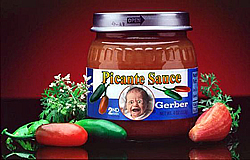
Pepper and Gerber Baby food.
=====================
Dr Al Wagner received his B.S. in Agricultural Education in 1969
from Texas A&M University. He received his M. S. and Ph.D.
in Food Sciences from Texas A&M University in 1972 and 1981,
respectively. Dr. Wagner is a Member of the Graduate Faculty of
Texas A&M University. He is also Associate Department Head,
Professor and Extension Program Leader for Horticulture. Dr Wagner
is interested in methods to extend shelf life of raw fruits and
vegetables and in working out methods to improve the quality of
our processed foods.
*I think a student should not be spoon fed and told what to do
in all situations. They should be allowed to be creative using
their own judgment I give guidance so a student does not wander
from the pertinent subject matter.*
LARRY STEIN: Growing peppers successfully
Dr. Larry Stein received his B.S. in horticulture
with emphasis on fruits and nuts from Texas A&M University
in 1979. He received his M.S. and Ph.D. in horticulture from Texas
A&M University in 1981 and 1985, respectively.
Stein*s emphasis has been on production horticulture working with
pecans, fruits, grapes and vegetable crops. He has done a lot
of work on variety screening both in fruits and vegetables. Some
of his work has focused on using drip irrigation to not only conserve
water, but to improve fruit quality and production. He is currently
doing a lot of work on crop load management of pecans via trunk
shaking. He is a contributing editor to PLANTanswers on the Web.
JERRY PARSONS: Hot peppers and insane
peppers
GOURMET CHILI PEPPER AND SALSA FESTIVAL
TRIAL IN 2007 AT WILDSEED FARMS JULY 28TH AND 29TH, 2007
======================================
======================================
Habanero, Hot Pepper Habanero - The famous 10-alarm pepper from
the Caribbean. The legendary hottest of all peppers, its name
means "from Havana." Habanero and its kin long ago migrated
from the Caribbean Islands to Central America where they remain
extremely popular today. A close relative of the Jamaican Scotch
Bonnet, the short, wrinkled, green fruits (1-1/2" long by
1" wide) turn yellow-orange. To complement its searing heat,
Habanero has a delicious, pungent, smoky quality unlike any other
pepper; many people find its flavor and aroma irresistible in
sauces and salsas. Most habaneros will rate between 100,000 and
300,000 Scoville units.
========================================
TAM Mild Habanero -- Capsicum chinese var. Habanero (originally
Spanish "Javanero") is the scientific name for the Habanero
Pepper. TAM Mild Habanero is a yellow fruit 10% as hot (10,000
to 30,000 Scoville units) as the standard orange Habanero. Kevin
Crosby, a Texas A&M Researcher in Weslaco, has recently created
a mild version of the habanero pepper which retains the aroma
and flavor of the traditionalhabanero pepper. The milder version
was obtained by crossing the Yucatan habanero pepper with a heatless
habanero from Bolivia over several generations.
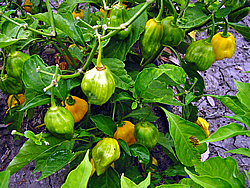
TAM Mild Habanero
===================
=========================================Okala - released from
Oklahoma by Dr. James Motes, this pepper is hotter than a Habanero
with a Scoville unit rating of 400,000.

Okala from Oklahoma
====================
=========================================
TAM Jaloro Yellow Jalapeño - 2 inch, yellow hot wax, maturing
to red. Similar shape and size to jalapeno, with typical cuticular
cracks. Scoville of 15-20,000. Resistant to four viruses and extremely
prolific small plant.
========================================
TAM Cascabella -- Small, round fruit that is usually dried and
has a distinct nutty flavor. The name is Spanish for "rattle"
or "jingle bell," and derives from the rattling noise
madeby the seeds inside the dried pod. Has rating of 3000 Scoville
units. Fruit is one inch long.
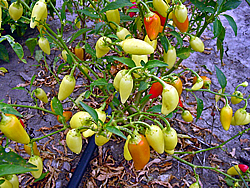
TAM Cascabella
===================
========================================
TAM Valley Hot Cayenne -- Long, thin fruit that was transported
by the Portuguese to China and India, where it is used widely.
Often dried and ground into powder. Has rating of 30,000 to 50,000
Scoville units. Fruit is about 5-7 inches long.
=======================================
TAM Mild Jalapeño II -- Jalapeño are botanically
classified as Capsicum annuum, of the Solanaceae family. TAM Mild
Jalapeño II are of mild flavor and reduced heat with a
fruit size larger than the original TAM Mild Jalapeño ,
and are used extensively in pickled form to spice dishes, and
in mash form as the main ingredient for mild hot sauces. The fruit
of TAM Mild Jalapeño II is 5-6 inches and has a Scoville
unit rating of about 2500.
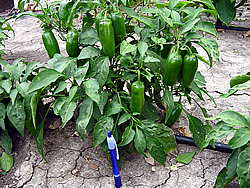
TAM Mild Jalapeno II
===================
======================================
Nethery LJOE (Largest Jalapeno On Earth) is a open-pollinated
selection from TAM Mild Jalapeño II made by Betty Nethery
of Junction, Texas over a ten year period. It is normally much
larger than TAM Mild Jalapeño II and has a Scoville unit
rating of about 2500 or hotter.
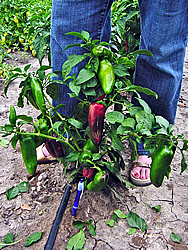
LJOE by Betty_Nethery
Click
here for a gallery of peppers featured at the Gourmet Chili Pepper
and Salsa Festival Trial on July 28th and 29th at Wildseed Farms.
Tuxtlas Serrano -- Thin, tapered fruit that is green when unripe
but turns red when mature. Due to its thin skin, it does not need
to be peeled before use. The fruit of Tuxtlas Serrano is 2 inches
and has a Scoville unit rating of 8,000 - 22,000.
======================================
Ixtapa Jalapeño -- Resistant to races 1, 2, and 3 of bacterial
leaf spot. Fruit similar to Grande.
======================================
Cubanelle Pepper -- A long slender banana-shaped pepper that
is considered to be a sweet pepper, despite having a mild to moderate
spicy heat. Ranging in color from green to yellow or red, this
pepper has a glossy outer skin that is smooth and firm in texture.
Also known as Italian frying pepper, this pepper is mildly hot
and very similar to an Anaheim pepper. Cabanelle peppers are often
used in casseroles, salads, pizzas, and as a pepper to be stuffed
with a savory filling.
======================================
Maroni Pepper - A long slender banana-shaped Cayenne pepper that
is considered to be a sweet pepper. Ranging in color from green
to yellow or red, this pepper has a glossy outer skin that is
smooth and firm in texture. Cayenne pepper is said to have originated
in Cayenne in French Guiana and the Maroni River forms the French
Guiana border in the west.
========================================
Grande* Jalapeño -- The jalapeño is a small to
medium-sized chile pepper that is prized for the hot, burning
sensation that it produces in the mouth when eaten. Ripe, the
jalapeño can be 2-3* inches (5-9 cm) and either red, or
more commonly, green. It is a cultivar of the species Capsicum
annuum. It is named after the city of Xalapa, Veracruz, where
it was traditionally produced. Jalapeños are a pod type
of Capsicum. The growing period for a jalapeño plant is
70-80 days. When mature, the plant stands two and a half to three
feet tall. Typically, a single plant will produce twenty five
to thirty five pods. During a growing period, a plant will be
picked multiple times. As the growing season comes to an end,
the jalapeños start to turn red. The jalapeño rates
between 2,500 and 10,000 Scoville units in heat - The Grande is
8 - 10,000.
==================================================
Parsons* Potent Chile Penguin (Red) -- A complete write-up with
images can be seen at:
http://www.plantanswers.com/parsons_pequins.htm
This is the ONLY plant Parsons has named for himself because
his wife Carolyn told him this was the only way to have the term
*Potent* associated with his name!? The Penguin name came with
the confusion with other common names of the plant such as chile
petin, chile pequin, piquin and chiltepin-Parsons can*t spell
so the name turned out to be Penguin since the shape of this fruit
is penguin-shaped. The true pequin pepper has a compact growth
habit with bright green, ovate leaves and small fruits that rarely
exceed 2 cm in length. Like most chiles, fruits start out green,
ripening to brilliant red at maturity. Pequin peppers are very
hot, often 7-8 times hotter than jalapeños on the Scoville
scale (30,000-60,000 units). Flavor is described as citrusy, smoky,
and nutty.Parsons* Potent Chile Penguin fruit are twice as large
as a standard pequin and four times hotter.
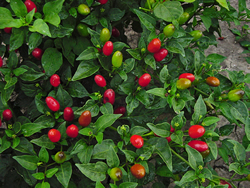
Parsons Potent Red
==========================
Parsons* Potent Chile Penguin (Yellow) -- Images can be seen
at:
http://www.plantanswers.com/parsons_pequins.htm
Parsons* Potent Chile Penguin (Yellow) is the same size as
the Red Penguin but is much hotter - some have said it is hotter
than a Habanero.
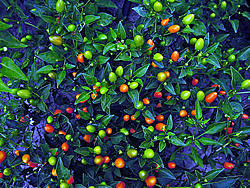
Parsons Potent Yellow
|
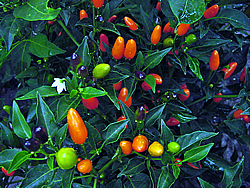
Parsons Potent Yellow, too
|
============================
==========================================
Jerry Parsons, Ph.D., is the horticulture specialist with the
Texas Cooperative Extension in San Antonio. He has been a popular
Extension personality for more than two decades, becoming something
of a cult figure in the agricultural world of South Texas. Parsons
has been responsible for educating and entertaining the Alamo
City and surrounding area with weekly horticultural information
on TV and radio and in newspaper for 25 years.
Parsons is without a doubt the most popular public gardening speaker
in the Lone Star State, sometimes deriding but always delighting
gardeners with his enthusiastic combination of irreverent and
educational humor.
Although his specialty is vegetable production, Parsons has revolutionized
the plant introduction arena and is the father of CEMAP (the Coordinated
Educational Marketing Assistance Program) at Texas A&M University.
Similar programs throughout the United States now copy the plant
introduction and promotion program.
Since 1974 when Parsons came to San Antonio as a horticulturist
for Texas Cooperative Extension, a system of testing and local
marketing has introduced productive hybrid tomatoes, Brussels
sprouts, cantaloupe, sweet corn, onion, squash, broccoli, spinach
cauliflower, mandarin oranges as container plants for colder climates
to Texas gardeners.
He also has introduced such popular flowers as *Blue Shade* Ruellia
and *Bonita* pink *Katie Dwarf Ruellia; *Tex Tuf verbenas, *Firebush*
(Hamelia patens); *Texas Gold* columbine; Indigo Spires* salvia;
*Carpet* petunias; *Mari Mum* marigold; *Plum Parfait*, *Eclipse*
and *Burgundy Sun* coleus; *Belinda*s Dream* rose; *Blue Princess*
verbena; *VIP* petunia and *Laura Bush* petunia; Firespike (Odontonema
strictum); *Moy Grande*, *Red River and *Flare* perennial hibiscus;
*Bunny Bloom* larkspur; Dwarf Bush Morning Glory; Purple Heart
(Setcreasea pallida). Stirring up a little controversy, he introduced
a host of new Texas bluebonnets colors such as *Barbara Bush*
lavender, Abbott Pink, and *Texas Maroon* (*Alamo Fire* -- his
and God*s own creations. He also developed the Texas state flower
into a bedding plant, spurring what is now a multi million dollar
industry.
Parsons began doing TV and radio shows in the late 1970s, both
locally and syndicated. He also wrote for the San Antonio Light
for 18 years, beginning in 1975. In 1999, Parsons began contributing
the Season to Season Calendar for South Central Texas to every
issue of the Neil Sperry Magazine. He launched KENS Radio (AM
1160) with his television gardening show on October 14, 1994.
The KENS radio 1160 AM Parsons Gardening Program lasted for 6
years. Parsons teamed with Bill McReynolds on the WOAI-AM (AM1200)
Gardening show for 17 years and teamed with Bill Cody and Jerry
King on KKYX-AM (AM 680) for the first gardening show in history
which incorporated country music with gardening information. Bill
and Jerry also used this format in Nashville, Tennessee, on the
Grand Old Opry station WSM-AM.
Parsons has been doing a call in radio program with Dr. Calvin
Finch, Bexar County ex Extension Horticulturist and a Director
of the San Antonio Water System, on Saturday and Sunday from 12:00
p.m. to 2:00 p.m. on KLUP Radio (AM 930) since 1999.
DAVID RODRIGUEZ: Beautiful landscape color in the Texas heat
David Rodriguez is an extension horticulturist for Texas Cooperative
Extension Bexar County, representing the Texas A&M University
System. The San Antonio native also serves as the coordinator
of the Master Gardener program for the area. He brings more than
27 years of local garden and yard experience to the table, graduating
from Texas A&M at College Station with a Masters degree in
1992.
His first taste in the garden came at the age of 10, working at
Grimm*s Nursery. His father worked with the Grimm family for more
than 50 years. In between classes at Mount Sacred Heart School
and Antonian Prep, he learned the ins and outs of the local greenery,
picking up tips on everything from wholesale gardening to residential
landscaping. He also put his knowledge to use at a number of other
local nurseries before taking the post with the University system.
JOHN R. THOMAS: Taking the wild out of wildflowers
John R Thomas is a native South Texan who grew up in a ranching
family in Eagle Lake, Texas. Thomas received his B.A. in Business
Administration from Sam Houston State University, and in 1971,
became a partner in the family*s cattle and farm operation
Combining his planting expertise, Texas ingenuity, and business
knowledge, Thomas initiated a turf seeding company in 1971 and
developed it into one of the largest companies of its kind in
the South. While seeding turf and native grasses in five states,
developers and landscape architects asked the question: *Why not
wildflowers?*
In response to this, Thomas formed Wildseed Farms and invented
two machines to produce the results he dreamed of: the J Thom
42 Wildseeder and Vacuum Seed Retriever (VSR). Mr. Thomas is now
considered one of the leading experts on wildflowers and is actively
used as a consultant top many state highway departments including
Texas, Oklahoma, Louisiana, Alabama, Florida and Ohio.
In 1997, John R. Thomas designed and constructed Wildseed Farms
Market Center located on 200 acres east of Fredericksburg, Texas,
on Highway 290. This working wildflower farm features walking
trails, display gardens, a nursery, a refreshment area, a large
gift shop and a live butterfly exhibit. Thomas is a member of
several professional societies, and is in demand as a speaker
on the natural blooming beauty of wildflowers at seminars, conventions
and clubs across the country.
Thomas* Wildseed Farms story has been highlighted in National
Geographic, The Wall Street Journal, Texas Highways, Southern
Living, (Country Living, American Profile, and national trade
magazines such as Nursery Manager, Progressive farmer, Texas Gardener,
and Garden Center Magazine.
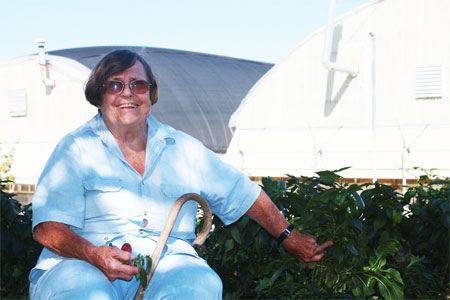
Betty Nethery with LJOE |
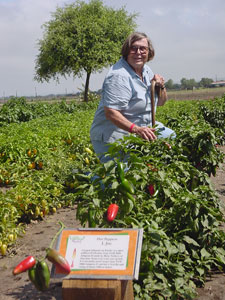
Betty Nethery with LJOE pepper at Wildseed Salsa & Pepper Festival |
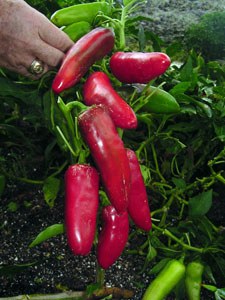
LJOE GIANTS in 2007 |
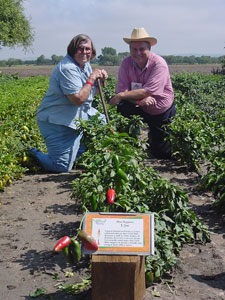
Nethery & Parsons with LJOE pepper at Salsa & Pepper Festival |
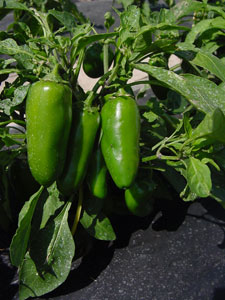
Nethery LJOE |
|



